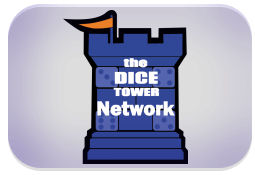Quick Board Game Reviews That Pack a Punch. No Rules, Just Opinions.


From the Publisher:Century: Spice Road is the first in a series of games that explores the history of each century with spice-trading
as the theme for the first installment. In Century: Spice Road, players are caravan leaders who travel
the famed silk road to deliver spices to the far reaches of the continent for fame and glory. Each turn, players perform one
of four actions:
- Establish a trade route (by taking a market card)
- Make a trade or harvest spices (by playing a card from hand)
- Fulfill a demand (by meeting a victory point card’s requirements and claiming it)
- Rest (by taking back into your hand all of the cards you’ve played)
The last round is triggered once a player has claimed their fifth victory point card, then whoever has the most victory points wins.

 Century: Spice Road is about as pure of an engine builder that I have ever played. There are only four actions: take a card, play a card, pick up the played cards, or fulfill a contract. The fun is in creating your engine by taking cards in the display at the right price, timing their use, and completing contracts as they cascade towards the spaces that give bonus points. It’s a real juggling act of efficiency, and opportunity. Take too long and someone else may grab what you want. Century: Spice Road is about as pure of an engine builder that I have ever played. There are only four actions: take a card, play a card, pick up the played cards, or fulfill a contract. The fun is in creating your engine by taking cards in the display at the right price, timing their use, and completing contracts as they cascade towards the spaces that give bonus points. It’s a real juggling act of efficiency, and opportunity. Take too long and someone else may grab what you want.
|
 It’s pretty easy to think of Century: Spice Road as a Splendor killer. It’s a lovely little engine builder that sees players racing to acquire resources and exchange them for points. Here, however, the market cards you acquire will allow have you swapping and converting your goods in an effort to claim victory point cards. Century: Spice Road keeps you on your toes by slowly revealing new market and victory point cards. Opportunities arise constantly but if you’re not quick your opponents may claim them. It’s pretty easy to think of Century: Spice Road as a Splendor killer. It’s a lovely little engine builder that sees players racing to acquire resources and exchange them for points. Here, however, the market cards you acquire will allow have you swapping and converting your goods in an effort to claim victory point cards. Century: Spice Road keeps you on your toes by slowly revealing new market and victory point cards. Opportunities arise constantly but if you’re not quick your opponents may claim them. |

 It’s hard not to compare this to Splendor. What makes Century: Spice Road different is the sliding display of trade routes and contracts, and the generation of the four resources, in this case, spices instead of gems. As you take trade routes, you pay a spice cube for each card past the first, so by buying further down the line, you leave resources for the other players. The other big difference is that you upgrade from Turmeric (yellow) in steps to Saffron (red), Cardamom (green), and finally Cinnamon (brown). There are some opportunities to generate higher level spices straight out, but you will have to pay heavily to get them first. In Century: Spice Road, the mechanics that can bog down Splendor are turned into a well-oiled machine. It’s hard not to compare this to Splendor. What makes Century: Spice Road different is the sliding display of trade routes and contracts, and the generation of the four resources, in this case, spices instead of gems. As you take trade routes, you pay a spice cube for each card past the first, so by buying further down the line, you leave resources for the other players. The other big difference is that you upgrade from Turmeric (yellow) in steps to Saffron (red), Cardamom (green), and finally Cinnamon (brown). There are some opportunities to generate higher level spices straight out, but you will have to pay heavily to get them first. In Century: Spice Road, the mechanics that can bog down Splendor are turned into a well-oiled machine. |
 There’s a bit of a hand-building element as market cards go to your hand and you choose how to play them to best meet your goals. A lot of the market cards are tempting, and more cards mean more ways to trade your goods. Each turn you spend acquiring one is one less turn you were trading goods, making each an interesting decision in timing and opportunity. At the end of the victory point card row, there are gold bonus coins on the first slot and slivers on the second which creates another timing decision. Should you grab the point card as soon as you can, or wait a round or two for it to cascade down to the bonus slots and hope no one snatches it out from under you? There’s a bit of a hand-building element as market cards go to your hand and you choose how to play them to best meet your goals. A lot of the market cards are tempting, and more cards mean more ways to trade your goods. Each turn you spend acquiring one is one less turn you were trading goods, making each an interesting decision in timing and opportunity. At the end of the victory point card row, there are gold bonus coins on the first slot and slivers on the second which creates another timing decision. Should you grab the point card as soon as you can, or wait a round or two for it to cascade down to the bonus slots and hope no one snatches it out from under you?
|

 In games this light, it’s hard to incorporate a theme effectively. The cards do evoke a feeling of negotiation to turn one set of spices into others. Some negotiations are more profitable than others, but you never feel dumb for making trades until you realize that maybe you’ve made one too many. It’s definitely a minimalist theme that doesn’t get in the way of playing the game. In games this light, it’s hard to incorporate a theme effectively. The cards do evoke a feeling of negotiation to turn one set of spices into others. Some negotiations are more profitable than others, but you never feel dumb for making trades until you realize that maybe you’ve made one too many. It’s definitely a minimalist theme that doesn’t get in the way of playing the game.
|
 The mechanics and theme work surprisingly well together. Playing the variety of market cards evoke a feeling of running around a crowded marketplace, visiting other spice traders you’ve personally curried favor with to fulfill contracts. In a more abstract way, the cascading rows of market and victory point cards represent a journey down the spice road, with new opportunities gradually revealing themselves. The mechanics and theme work surprisingly well together. Playing the variety of market cards evoke a feeling of running around a crowded marketplace, visiting other spice traders you’ve personally curried favor with to fulfill contracts. In a more abstract way, the cascading rows of market and victory point cards represent a journey down the spice road, with new opportunities gradually revealing themselves. |

 The card art has a varied amount of scenes nicely illustrated. The metal coins look and feel like a different time and a different land. The way it all sits on the table though doesn’t make for a pleasant overall look. I was fortunate to get the neoprene playmat in the pre-order, and to me, it makes all the difference. It really pulls the middle east aesthetic together. It doesn’t improve the gameplay at all, but it looks amazing on my table. The card art has a varied amount of scenes nicely illustrated. The metal coins look and feel like a different time and a different land. The way it all sits on the table though doesn’t make for a pleasant overall look. I was fortunate to get the neoprene playmat in the pre-order, and to me, it makes all the difference. It really pulls the middle east aesthetic together. It doesn’t improve the gameplay at all, but it looks amazing on my table.
|
 It’s such a beautiful production, from the lovely illustrations by Fernanda Suarez which adorn each card to the subtle woody texture on the component bowls. The metal coins are a nice touch, but I wish the gold ones were a touch darker to make them a little easier to tell apart from the silvers. I hope Plan B has plans to produce more of the drop-dead gorgeous playmats that quickly sold out to folks who pre-ordered, as it makes the game looks absolutely stunning on the table. It’s such a beautiful production, from the lovely illustrations by Fernanda Suarez which adorn each card to the subtle woody texture on the component bowls. The metal coins are a nice touch, but I wish the gold ones were a touch darker to make them a little easier to tell apart from the silvers. I hope Plan B has plans to produce more of the drop-dead gorgeous playmats that quickly sold out to folks who pre-ordered, as it makes the game looks absolutely stunning on the table. |

 The MSRP on Century: Spice Road is $39.99, and that feels right to me. The cards are oversized and easy to hold and pick up. The art is fantastic. The bowls that hold the spices are easy to use, and the insert lets you use them as storage by making them sit right under the lid. Plan B did a great job on production, and Emerson Matsuuchi really nailed it on the gameplay. The MSRP on Century: Spice Road is $39.99, and that feels right to me. The cards are oversized and easy to hold and pick up. The art is fantastic. The bowls that hold the spices are easy to use, and the insert lets you use them as storage by making them sit right under the lid. Plan B did a great job on production, and Emerson Matsuuchi really nailed it on the gameplay.
|
 Forty bucks is definitely the right price. Century: Spice Road is the rare game that handles different player counts and experience levels with ease. In addition to the intriguing gameplay, the excellent artwork and lovely components really stand out. The insert and component bowls are such a nice touch when most other publishers are content to just toss a few baggies at you. I’ll be keeping a close eye on future Plan B productions. Forty bucks is definitely the right price. Century: Spice Road is the rare game that handles different player counts and experience levels with ease. In addition to the intriguing gameplay, the excellent artwork and lovely components really stand out. The insert and component bowls are such a nice touch when most other publishers are content to just toss a few baggies at you. I’ll be keeping a close eye on future Plan B productions. |

 Century: Spice Road is a stripped down, no frills race to completing contracts. It plays up to 5 well, and will be one of the few games I am willing to suggest at that player count. Century: Spice Road also makes for a great 2 player filler which seems to be a rare versatility in board games. While there is still luck of the draw, the game encourages you to plan for different opportunities, and there are plenty of opportunities that crop up. I love the planning and the tension I feel. I give it a 5, and if it can hold my attention over time it may even move up to a 6. Century: Spice Road is a stripped down, no frills race to completing contracts. It plays up to 5 well, and will be one of the few games I am willing to suggest at that player count. Century: Spice Road also makes for a great 2 player filler which seems to be a rare versatility in board games. While there is still luck of the draw, the game encourages you to plan for different opportunities, and there are plenty of opportunities that crop up. I love the planning and the tension I feel. I give it a 5, and if it can hold my attention over time it may even move up to a 6. |
 There’s a lot in Century: Spice Road that is right in my wheelhouse. Gorgeous art, simple mechanics, tense gameplay, and a solid theme make this one a welcome addition in almost any collection. With the goods exchange and the cascading rows of cards, I feel a little more in control when playing compared to Splendor. As the first entry in the planned Century trilogy of games, I’m really excited to see what’s next in the series. Century: Spice Road earns a very high 5 from me. And did I mention it’s gorgeous? There’s a lot in Century: Spice Road that is right in my wheelhouse. Gorgeous art, simple mechanics, tense gameplay, and a solid theme make this one a welcome addition in almost any collection. With the goods exchange and the cascading rows of cards, I feel a little more in control when playing compared to Splendor. As the first entry in the planned Century trilogy of games, I’m really excited to see what’s next in the series. Century: Spice Road earns a very high 5 from me. And did I mention it’s gorgeous?
|
| The Dukes of Dice Rating System |
|---|
| 1 = Poorly designed but playable. Not necessarily fun. |
| 2 = Game has some merit but has significant detractions. |
| 3 = Game is okay, not exciting. Will play in the right situation. |
| 4 = A good game. Worth playing, just not all the time. Belongs in the Duchy. |
| 5 = A great game, will rarely turn down a play of it. |
| 6 = An all-time favorite that is a contender for the top 10 |
If you want to connect with us you can find:
Matthew on Twitter as @uncouthtooth or matthew@dukesofdice.com
Matt on Twitter as @matosowalker
Join the discussion in our Board Game Geek Guild on this review HERE










1 ping
HeavyCon Recap with Matthew Ward | Board Game Gumbo
June 27, 2017 at 1:48 am (UTC 0) Link to this comment
[…] spectrum of games. He also contributes to an excellent series of short reviews, like this one of Century: Spice Road, with his friend, Matthew Walker, known collectively as WAM! (“We Are Matt”). Here are […]